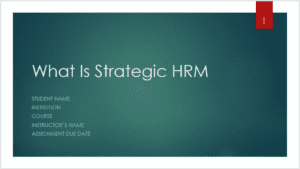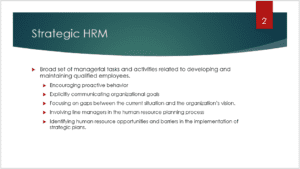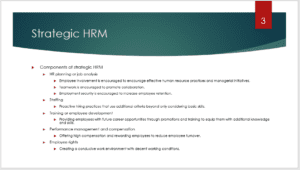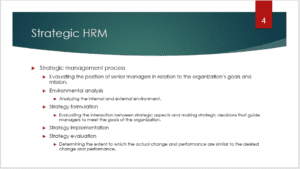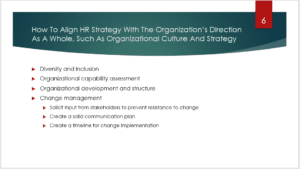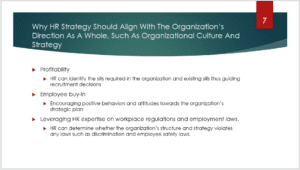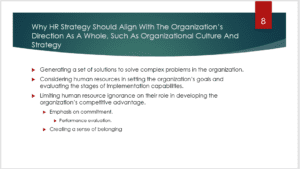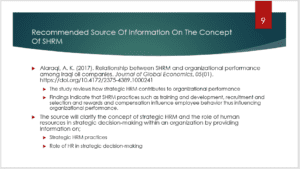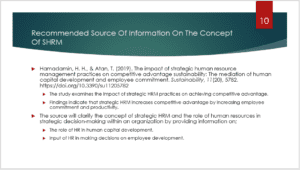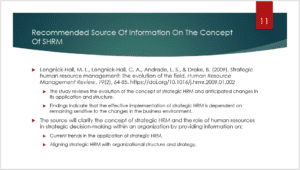Strategic Human Resource Management
Hello, welcome to my presentation on the concept of strategic Human Resource Management.
According to Truss et al. (2012), strategic HRM is a broad set of managerial tasks and activities related to developing and maintaining qualified employees. It is characterized by encouraging proactive behavior, explicitly communicating organizational goals, focusing on gaps between the current situation and the organization’s vision, involving line managers in the human resource planning process and identifying human resource opportunities and barriers in implementing strategic plans. Our assignment help will hone your writing prowess for papers that will awe your professors.
The main components of strategic HRM are HR planning or job analysis, staffing, training or employee development, performance management and compensation and employee rights. HR planning or job analysis includes employee involvement to encourage effective human resource practices and managerial initiatives. Teamwork is encouraged to promote collaboration, and employment security is encouraged to increase employee retention. Staffing includes proactive hiring practices that use additional criteria beyond only considering basic skills. Subsequently, training or employee development includes providing employees with future career opportunities through promotions and training to equip them with additional knowledge and skills. Performance management and compensation include offering high compensation and rewarding employees to reduce employee turnover. Employee rights include creating a conducive work environment with decent working conditions.
According to Blokdyk (2018), the strategic management process includes different steps. The first step is evaluating the position of senior managers in relation to the organization’s goals and mission. The second step is an environmental analysis, which includes analyzing the internal and external environment. The third step is strategy formulation, which involves evaluating the interaction between strategic aspects and making strategic decisions that guide managers to meet the organization’s goals. The fourth step is strategy implementation. The final step is strategy evaluation, which includes determining the extent to which the actual change and performance are similar to the desired change and performance.
One of the steps that can be taken to align HR strategy with the organization’s direction as a whole, such as organizational culture and strategy, is workforce planning (Boxall, 2011). This step includes analyzing organizational strategic goals, determining the competencies needed to attain those goals, performing a talent assessment, conducting a labor market analysis and identifying the gap between existing capabilities and the organization’s needs to create a foundation for talent development.
The second step in aligning HR strategy with the organization’s direction, such as organizational culture and strategy, is diversity and inclusion, followed by organizational capability assessment. The next step is organizational development, followed by change management, which includes soliciting input from stakeholders to prevent resistance to change, creating a solid communication plan and creating a timeline for change implementation (Boxall, 2011).
HR strategy should align with the organization’s direction as a whole, such as organizational culture and strategy to increase profitability, enhance employee buy-in and leverage HR expertise on workplace regulations and employment laws. HR can identify the skills required in the organization and existing ones, thus guiding recruitment decisions to acquire the best talent, thereby increasing profitability. An organization can encourage positive behaviors and attitudes toward the organization’s strategic plan through employee buy-in. HRs can determine whether the organization’s structure and strategy violate any discrimination and employee safety laws.
Accordingly, HR strategy should align with the organization’s direction as a whole, such as organizational culture and strategy to generate a set of solutions to solve complex problems in the organization, consider human resources in setting the organization’s goals and evaluate the stages of implementation capabilities. The strategy also limits human resource ignorance on their role in developing the organization’s competitive advantage through an emphasis on commitment by conducting performance evaluation and creating a sense of belonging by involving employees in decision-making.
Alaraqi (2017) reviews how strategic HRM contributes to organizational performance. The researcher concludes that SHRM practices such as training and development, recruitment and selection, and rewards and compensation influence employee behavior, thus influencing organizational performance. The source also clarifies the concept of strategic HRM and the role of human resources in strategic decision-making within an organization by providing information on strategic HRM practices and the role of HR in strategic decision-making.
Hamadamin & Atan (2019) examine the impact of strategic HRM practices on achieving competitive advantage. These authors conclude that strategic HRM increases competitive advantage by increasing employee commitment and productivity. The source also clarifies the concept of strategic HRM and the role of human resources in strategic decision-making within an organization by providing information on the role of HR in human capital development and the input of HR in making decisions on employee development.
Lengnick-Hall et al. (2009) review the evolution of the concept of strategic HRM and anticipated changes in its application and structure. The authors conclude that the effective implementation of strategic HRM is dependent on remaining sensitive to the changes in the business environment. Additionally, the source clarifies the concept of strategic HRM and the role of human resources in strategic decision-making within an organization by providing information on current trends in the application of strategic HRM and aligning strategic HRM with organizational structure and strategy.
Alaraqi, A. K. (2017). Relationship between SHRM and organizational performance among Iraqi oil companies. Journal of Global Economics, 05(01). https://doi.org/10.4172/2375-4389.1000241
Blokdyk, G. (2018). Strategic management process a complete guide. 5starcooks.
Boxall, P. (2011). Human capital, HR strategy, and organizational effectiveness. Oxford Handbooks Online. https://doi.org/10.1093/oxfordhb/9780199532162.003.0012
Hamadamin, H. H., & Atan, T. (2019). The impact of strategic human resource management practices on competitive advantage sustainability: The mediation of human capital development and employee commitment. Sustainability, 11(20), 5782. https://doi.org/10.3390/su11205782
Lengnick-Hall, M. L., Lengnick-Hall, C. A., Andrade, L. S., & Drake, B. (2009). Strategic human resource management: The evolution of the field. Human Resource Management Review, 19(2), 64-85. https://doi.org/10.1016/j.hrmr.2009.01.002
Truss, C., Mankin, D., & Kelliher, C. (2012). Strategic human resource management. Oxford University Press.
ORDER A PLAGIARISM-FREE PAPER HERE
We’ll write everything from scratch
Question
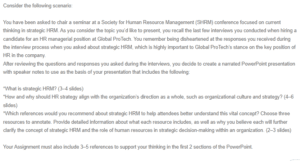
Strategic Human Resource Management
Consider the following scenario:
You have been asked to chair a seminar at a Society for Human Resource Management (SHRM) conference focused on current thinking in strategic HRM. As you consider the topic you’d like to present, you recall the last few interviews you conducted when hiring a candidate for an HR managerial position at Global ProTech. You remember being disheartened at the responses you received during the interview process when you asked about strategic HRM, which is highly important to Global ProTech’s stance on the key position of HR in the company.
After reviewing the questions and responses you asked during the interviews, you decide to create a narrated PowerPoint presentation with speaker notes to use as the basis of your presentation that includes the following:
*What is strategic HRM? (3–4 slides)
*How and why should HR strategy align with the organization’s direction as a whole, such as organizational culture and strategy? (4–6 slides)
*Which references would you recommend about strategic HRM to help attendees better understand this vital concept? Choose three resources to annotate. Provide detailed information about what each resource includes, as well as why you believe each will further clarify the concept of strategic HRM and the role of human resources in strategic decision-making within an organization. (2–3 slides)
Your Assignment must also include 3–5 references to support your thinking in the first 2 sections of the PowerPoint.

